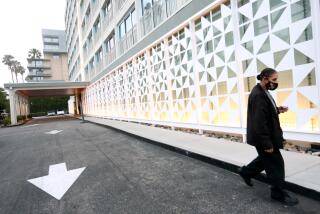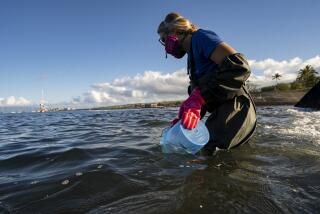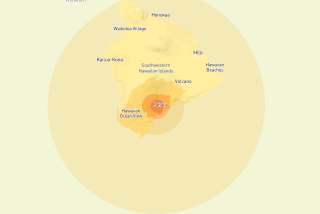From destruction, creation: A new black sand beach is born on the island of Hawaii
The eight-mile-long river of lava that poured down the slopes of Kilauea volcano on the island of Hawaii last spring destroyed nearly everything in its path — roads, houses and cars. It upended lives and the tourism industry, scaring away about $480 million in business.
But part of what it left behind offers a glimmer of hope for the battered land and economy: a new black sand beach.
In early December, I visited the island to see what the destructive lava flow had done to the largest of the Hawaiian Islands and to visit the newly formed crescent beach at Isaac Hale Beach Park, also known as Pohoiki.
When the lava flowed down the slopes of Kilauea’s Lower East Rift Zone, many people assumed the beach park would be destroyed, but the lava stopped 230 feet from the boat ramp and emptied into the sea. Instead of destroying Pohoiki, it created a black sand beach, two surf breaks and three thermal ponds.
As I was drove the narrow, two-lane highway known as the Red Road (Hawaii 137) around the rocky coastline of lower Puna, I was reminded that this wild, tropical terrain at the base of Kilauea is unlike anywhere else in the islands.
Until recently, many visitors came here by land or sea hoping to catch a glimpse of molten lava.
Now they are coming to see not what was destroyed but what was created.
Gathering place
This isn’t the first time a black sand beach was produced during Kilauea’s 35 years of ongoing eruptions, nor is it the only one born of last year’s eruption, but it is the largest black sand beach created in the islands in recent times.
When word got out there was now a black sand beach at Pohoiki, visitors and residents hiked over a rugged lava field to be among the first to see it.
Leomana Turalde, a native Hawaiian, traveled from Hilo with his younger brother and his daughter. The creation of a beach was a lesson for the younger family members, he said, about Hawaiian culture.
“I tell them Hawaiian language and culture lives through the chant and the dances and the songs that we have, so if we don’t go out and experience things and record them and take note and just be the first here, then how do [they] expect the tradition that we carry to continue on?” he said.
Pohoiki has served the community as a family gathering place for generations. “When the lava was coming down, a lot of the community was sharing memories about certain spots,” Turalde said. “Those areas are gone, but it’s exciting for us now that we have this new beach … a huge black sand beach we didn’t have before.”
How this beach came to be begins with hot lava and cold water, said Tina Neal, scientist in charge at the USGS Hawaiian Volcano Observatory, which has temporarily relocated to Hilo from Hawaii Volcanoes National Park.
“Hot molten lava interacting with cold ocean water produces explosions,” Neal said. “Part of that is wave action breaking up the new lava. All of that produces a source of sand, and that sand is carried by the ocean current down the coastline to the places where it will naturally accumulate.”
The long, wide beach is gorgeous, shaped like a crescent moon. The sand is a mix of textures, from fine grains to small, rough rocks, which, in time, will be ground down by the waves.
The landscape reminded me of long-lost Kaimu Beach about 11 miles away near Kalapana. Its black sand was framed by a backdrop of palm trees and was thought to be Hawaii’s most photographed black sand beach until it was overrun by lava in 1990. A new, smaller beach exists in its place.
Blessings and offerings
I walked from one end of the beach to the other, my feet crunching in the sand, as I took it in. People of all ages were swimming in the largest of the newly created ponds, formed when the black sand beach surrounded the once popular Pohoiki Boat Ramp, used to launch small craft.
It’s unknown whether the Hawaii State Department of Land and Natural Resources will dredge the sand blocking the boat ramp so it can be used, but for now, the place has become a popular swimming hole.
Swimming in the ocean here isn’t advised because of the strong currents and dangerous shore break, but that doesn’t deter the handful of surfers who find a thrill in a new spot.
Meanwhile, on the day of my visit, a kahu (priest) blessed the beach with prayers and Hawaiian oli (chants) and led a procession of cultural offerings.
Men, women and children lined up to leave leis and wrapped ti-leaf bundles on the beach as a sign of respect and gratitude.
“Those in the audience that have been tremendously hurt by the lava, this is a … way that gives you a lot of feeling of goodness,” Hawaii County Mayor Harry Kim told the crowd.
“I ask all of us to take care of this place. It is a special place to a lot of people.”
Like other beaches, this one is at the mercy of erosion from the surf and other changes wrought by time. But as history has shown in this land ruled by Kilauea, change can come all too quickly, so it’s best to make memories now and cherish the time it’s here.
If you go
Isaac Hale Beach Park, 13-101 Kalapana-Kapoho Road, Pahoa. Open 9 a.m.-6 p.m. daily. No drinking water. No camping.
More to Read
Sign up for The Wild
We’ll help you find the best places to hike, bike and run, as well as the perfect silent spots for meditation and yoga.
You may occasionally receive promotional content from the Los Angeles Times.






